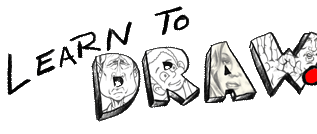|
One thing that happens a lot when you're drawing
hands is having to sometimes deal with extreme instances
of proportion and perspective. For example when a finger
is pointing almost directly at you, or your subject's
arm is bent in such a way that the forearm is totally
blocking the upper arm. How would would you draw
something like these examples? Your logical mind begins
to freak out because the portion of the body that you
want to draw is angled in such a way that the body part
no longer really looks like what it is. Let me show you
what I mean. Can you tell what the image is on the
right?
Click it to find out.
What's happening with the pointed finger is that it's at such an angle that it's
difficult to tell that it's a finger without seeing the whole hand. Your mind
needs a context to place the object that it doesn't understand. So when your
mind sees the whole hand, it understands that the object it didn't understand
earlier is a finger. This happens a lot in figure drawing, so let's talk about
how we can draw objects that are in extreme proportion or perspective (or both).
 |
|
Click to enlarge |
The easy answer is to break the figure down into three dimensional cylinders
like we did
earlier in this section. When
your subject appears daunting, break it down into manageable pieces. So let's
look at another hand where all the fingers have extreme perspective. Looking at
each finger of this hand, at first look, the fingers appear to be way too short
and stubby. But that's because in drawing, we're confined to the two dimensions
of the paper. So in order to accomplish drawing this three dimensional hand
where the fingers are pointing towards us, we need to visualize the fingers as
three dimensional simple cylinders that are easy to draw in perspective. Go
ahead and
click on the hand and see how the drawing is broken down into
cylinders.
 |
|
Click to enlarge |
The fingers above are coming out at you - but the idea of breaking down the
figure works just as well when the body part is angling away from you, too. Look
for example at the drawing of the bare back. The left upper and forearm (the
whole arm) is angling away from your eye. The left forearm is also mostly
obscured by the upper arm. With the right arm, the upper arm is pretty much
parallel to your eye, but the right forearm is also angling away from your eye.
So if you break the arms up into cylinders in your mind, you should be able to
visualize how the arms are placed in space, and you should be able to draw
simple cylinders to understand the layout of your drawing. Remember, since the
arms are angling away from your eye, the arms and hands will appear smaller than
they actually are. So it might be better if you did some measuring to get the
proper size relationships of the objects to the other objects in your
composition. If you envision your figure as stacks of simple three dimensional
cylinders that are angled away or towards your eye, drawing extreme proportion
and perspective will become easier and more comfortable for you to draw.
|
